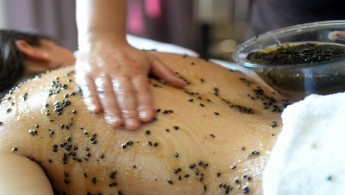Moroccan hot springs attract medical tourists
Every year, Abdullah Mahmoudi, a Moroccan man in his 60s makes his annual visit to the Moulay Yacoub hot springs near Fez, the spiritual capital of Morocco, to treat the skin condition he suffers from, and he claims that he feels better with every visit.
The Moulay Yacoub hot springs that are famous for their healing properties are not the only springs that attract medical tourists in Morocco, as the Sidi Harazem spring, the Ain Allah spring and the Ain al-Ati spring in addition to several others make the country a destination for medical tourists and contribute important revenues to the economy.
The secrets of Moulay Yacoub
The Moulay Yacoub hot springs were discovered in 1900, however they were not habilitated for general public use until 1965, when the local authorities constructed bathhouses and other facilities for the use of the springs.
| The waters of Moulay Yacoub realty do have healing properties for some conditions, especially skin conditions |
"I come here every year and it's had many benefits on my health. I've been cured of the medical condition that I suffered from but I still come as a preventative measure," said Abdullah Mahmoudi.
Moroccan authorities confirm that they have conducted tests on the waters of the springs revealing high mineral content and making them ideal to sure a number of conditions.
"The waters of Moulay Yacoub realty do have healing properties for some conditions, especially skin conditions and urinary tract infections as the waters help dissolve stones that form in the kidneys," said Dr. Mamoun Shaker, a dermatologist.
Shaker said the water of the springs contains high levels of calcium, sodium, sulfate and magnesium, that can help remedy a number of skin conditions and provide pain relief for arthritis, however Shaker stressed that it cannot be claimed that the waters can completely and effectively treat these conditions.
Tourism boom
Frederic Lenoir, a retired French tourist in his late 50s says that he regularly visits the springs at Moulay Yacoub, after hearing about the springs' healing powers, however the waters have made no difference with his condition.
Ahmed Farrak, an official at one of the facilities at Moulay Yacoub told al-Araby al-Jadeed that such allegations are nothing new.
"Not everyone who swims in the waters of Moulay Yacoub or drinks from the waters of Sidi Harazem will be cured, as a patient needs to undergo a medically supervised course," said Farrak.
Farrak confirmed that official figures reveal that the Moulay Yacoub and other hot springs around Fez have revived the local tourism industry and attracted thousands of tourists from Morocco and abroad.
| With the arrival of large numbers of tourists, some people have attempted to take advantage of the unsuspecting travellers |
The areas around the various hot springs in the governorate of Fez have seen an increase in economic activity with the establishment of businesses primarily geared towards visitors of the springs.
"The Sidi Harrazem spring saved me from unemployment, after being out of work for several years. I opened a small food stall that sells light snacks to the visitors of the spring, and my financial situation has improved ever since," said Khaled, a young man who owns a small business at the Sidi Harrazem spring.
However, with the arrival of large numbers of tourists, some people have attempted to take advantage of the unsuspecting travellers by charging them extortionate amounts for simple services and other predatory behaviors.
The Ain al-Ati spring
Unlike other hot springs around Morocco, the Ain al-Ati hot springs in Erfoud, southeast of the country, which were named by the late King Hassan II in 1984 after a geyser suddenly erupted, contains sulfuric water.
While the springs can be used for therapeutic and medicinal treatments, the sulfuric content of the water is highly damaging to the neighbouring farmlands and has been seeping into the area's groundwater, creating real problems for the area's residents.
Despite this, residents of the area have divergent views of how to deal with the issue, with some calling for the springs to be blocked and shut down to minimize damage to ground water and farmland, while others argue that the springs provide treatment for thousands of visitors and have immense economic value to the area.



